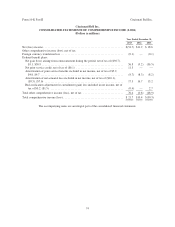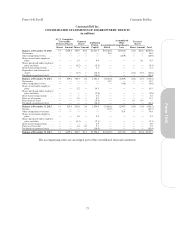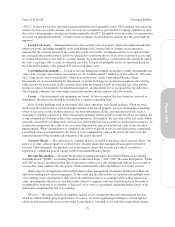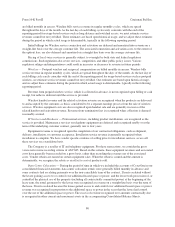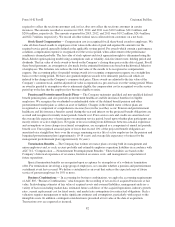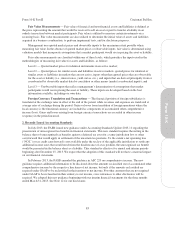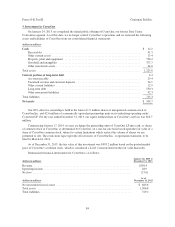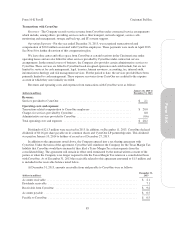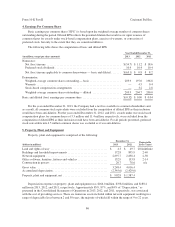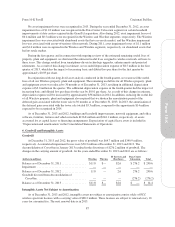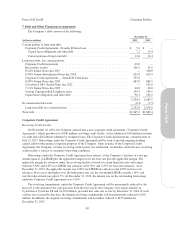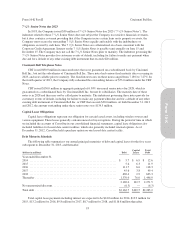Cincinnati Bell 2013 Annual Report Download - page 163
Download and view the complete annual report
Please find page 163 of the 2013 Cincinnati Bell annual report below. You can navigate through the pages in the report by either clicking on the pages listed below, or by using the keyword search tool below to find specific information within the annual report.
Form 10-K Part II Cincinnati Bell Inc.
Fair Value Measurements — Fair value of financial and non-financial assets and liabilities is defined as
the price representing the amount that would be received to sell an asset or paid to transfer a liability in an
orderly transaction between market participants. Fair value is utilized to measure certain investments on a
recurring basis. Fair value measurements are also utilized to determine the initial value of assets and liabilities
acquired in a business combination, to perform impairment tests, and for disclosure purposes.
Management uses quoted market prices and observable inputs to the maximum extent possible when
measuring fair value. In the absence of quoted market prices or observable inputs, fair value is determined using
valuation models that incorporate assumptions that a market participant would use in pricing the asset or liability.
Fair value measurements are classified within one of three levels, which prioritize the inputs used in the
methodologies of measuring fair value for assets and liabilities, as follows:
Level 1 — Quoted market prices for identical instruments in an active market;
Level 2 — Quoted prices for similar assets and liabilities in active markets, quoted prices for identical or
similar assets or liabilities in markets that are not active, inputs other than quoted prices that are observable
for the asset or liability (i.e., interest rates, yield curves, etc.), and inputs that are derived principally from or
corroborated by observable market data by correlation or other means (market corroborated inputs); and
Level 3 — Unobservable inputs that reflect management’s determination of assumptions that market
participants would use in pricing the asset or liability. These inputs are developed based on the best
information available, including our own data.
Foreign Currency Translation and Transactions — The financial position of foreign subsidiaries is
translated at the exchange rates in effect at the end of the period, while revenues and expenses are translated at
average rates of exchange during the period. Gains or losses from translation of foreign operations where the
local currency is the functional currency are included as components of accumulated other comprehensive
income (loss). Gains and losses arising from foreign currency transactions are recorded in other income
(expense) in the period incurred.
2. Recently Issued Accounting Standards
In July 2013, the FASB issued new guidance under Accounting Standards Update 2013-11 regarding the
presentation of unrecognized tax benefits in financial statements. This new standard requires the netting in the
balance sheet of unrecognized tax benefits against a deferred tax asset for a same-jurisdiction loss or other
carryforward that would apply in settlement of the uncertain tax positions. To the extent a net operating loss
(“NOL”) or tax credit carryforward is not available under the tax law of the applicable jurisdiction to settle any
additional income taxes that would result from the disallowance of a tax position, the unrecognized tax benefit
would be presented in the balance sheet as a liability. This standard is effective for annual and interim periods
beginning after December 15, 2013. We expect that the adoption of this standard will not have a material impact
on our financial statements.
In February 2013, the FASB amended the guidance in ASC 220 on comprehensive income. The new
guidance requires additional information to be disclosed about the amounts reclassified out of accumulated other
comprehensive income by the respective line items of net income, but only if the amounts reclassified are
required under GAAP to be reclassified in their entirety to net income. For other amounts that are not required
under GAAP to be reclassified in their entirety to net income, cross references to other disclosures will be
required. We adopted this new guidance beginning with our interim financial statements for the three months
ended March 31, 2013. See Note 12 for our disclosures.
83
Form 10-K



